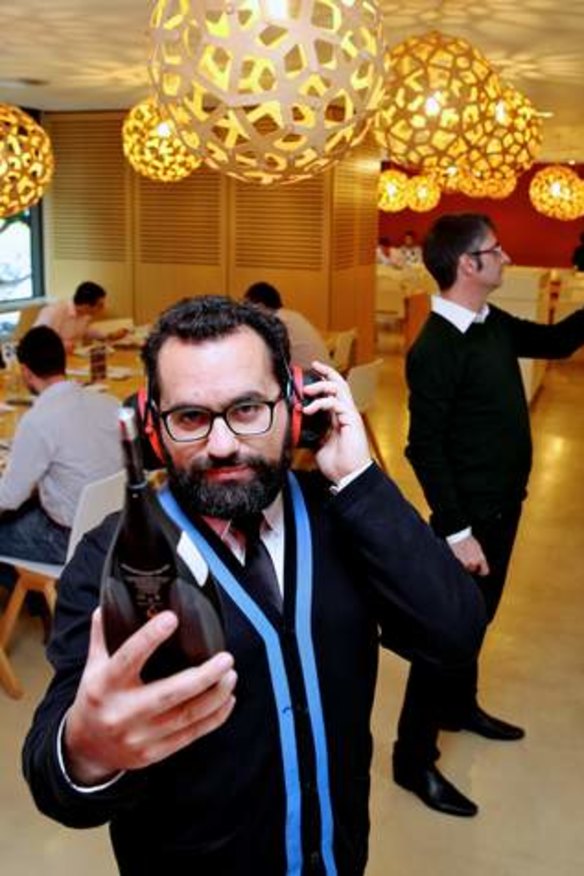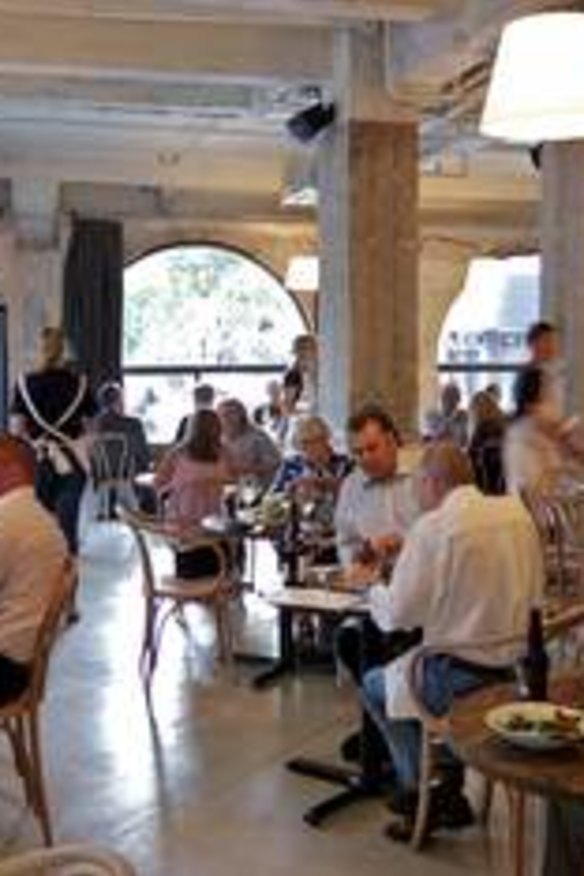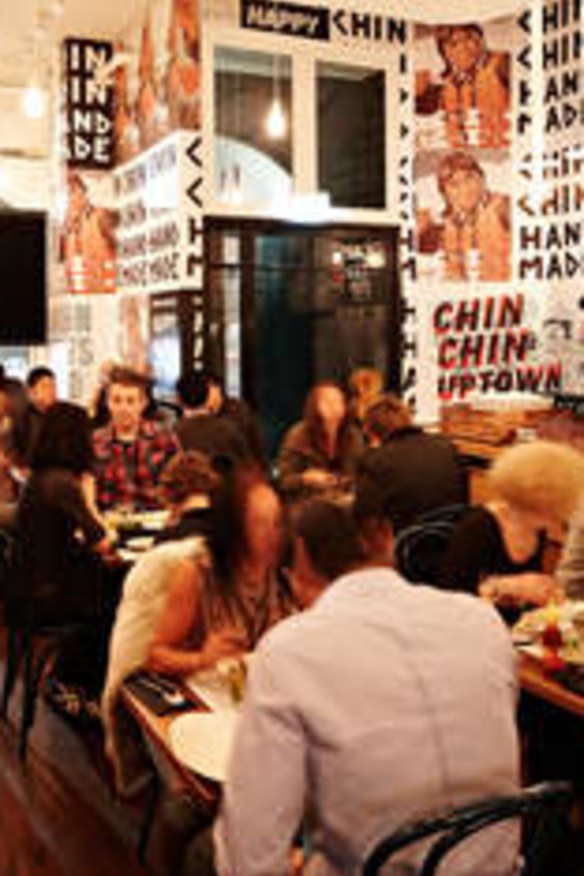Din and dinner: Are our restaurants just too noisy?
Bare walls, concrete floors, thumping music - restaurants are getting noisier as they chase that elusive buzz. Now, experts warn, we're risking not only our hearing but even our sense of taste.

The wall of noise is almost impenetrable. I have to ask the maitre 'd to speak up. "Follow me," she says loudly, not quite shouting. It's a weeknight at Apollo, a modern Greek restaurant in the affluent Sydney suburb of Potts Point. The room is beautiful in its simplicity. Marble bar and wooden table, concrete floors and pillars jackhammered to reveal distressed concrete. And it's full. Full and noisy. My dining companions lean across the table to make themselves heard.
"Bare glass. Bare walls. Bare tables," says Daniel Castro from Wood and Grieve Engineers. "This is a perfect recipe for a noisy restaurant. All those reflective surfaces and nothing to absorb the sound."
"There's not much here to stop the reverberating," Jorge Reverter from Acoustic Studio says. And they should know. Castro and Reverter are top Spanish acoustic engineers working for two Sydney-based Australian engineering firms. Both men specialise in isolating and reducing noise where we work, learn and socialise.

Castro pulls out a decibel meter, a device that measures sound energy; the readings are between 75 and 88 decibels, or dBs. "That's getting up to a level where there could be workplace issues," he says.
In Victoria and NSW, 85 dBs is the end of the WorkCover safe limit at which workers can complete an eight-hour day without wearing ear protection.
"Noise is an important problem for both the dining public and our members," says Louise Tarrant, the national secretary of hospitality union United Voice. "Noise has escalated with the rise in the trend for minimalist [decor in] restaurants, and we're concerned that restaurant owners aren't taking the problem seriously because they even want to increase the allowable noise levels," she says.

In 2011, Restaurant and Catering Australia lodged a submission with Safe Work Australia stating that because the "average noise levels in restaurants range between 50 and 90 decibels", "the acceptable standard for noise levels in the workplace should be lifted from 85 decibels to 100 decibels". This is similar to standing near a power drill.
"I don't think it would be a great look for the wait-staff and patrons to have to wear protective ear wear in a restaurant," Tarrant says.
Reverter and Castro note that noise in restaurants is a growing problem worldwide as financial crises see the roll-out of restaurants designed for profit, not comfort.

Stephanie Olsen agrees. She works for Knauf, which manufactures sound-absorbing plasterboard. "Modern design in restaurants has a focus on minimalism, and it's becoming more and more of a problem as people struggle to make themselves heard." Her company recently launched Dine Hear, a marketing campaign to raise awareness of the issue.
"Architects and restaurant designers used to go to a great deal of trouble to make intimate spaces where people could go to make conversation," Olsen says. "You go to restaurants to be social. These days, you often come out none the wiser of what the other person has said."
Olsen describes a classic fine-dining restaurant of the recent past as having drapes by the windows, carpet on the floor, textured wallpaper and linen on the table. "All those materials absorb sound," she says. "But they are all expensive to install and maintain. Minimal is much cheaper – but it's very noisy."

Roslyn Grundy, co-editor of The Age Good Food Guide 2014 (due out on August 27), says noise is a constant source of annoyance to Guide users and many ask for "quiet restaurant" recommendations. "We get a lot of feedback from people saying that at some places, they can't hear the conversation at their own table, let alone eavesdrop on the person next to them," she says.
For Melbourne restaurateur Chris Lucas, noise is just another tool to create successful restaurants. "It has been pointed out to me that I have a penchant for noisy restaurants," says Lucas, owner of city hot spots Chin Chin and Go Go Bar, and the Italian eatery Baby in Richmond. "You can't have fun without noise. When we set out to replicate the buzz of a Thai street market with Chin Chin, we did it carefully. I don't like four empty walls with no buzz."
Music plays a big part in Lucas's restaurants, with a team of people working on a range of playlists that change with the seasons. During service, staff turn up the music while the restaurants are filling, then down again during peak periods so the diners don't have to talk louder over the music and cause other diners to talk even louder, which leads to an internecine battle of shouting. At present Lucas finds '80s music is appealing to a broad range of customers, while he says "doof doof" never works.
The food at Chin Chin is young, fun and Asian inspired. The flavours are fresh, the textures crunchy, and hot and sweet dishes are menu favourites, which is just as well – noise has been proved to affect one's ability to taste. "Especially sweet and salty food," says Russell Keast, an associate professor of food and sensory science at Deakin University who is known in the business as "the taste professor".
Standing in his laboratory in Burwood in suburban Melbourne, we are about to roughly replicate aspects of an experiment performed in England's University of Manchester that proved that high levels of background noise reduced a taster's ability to detect salt and sweet foods, but increased their enjoyment of crunchy foods.
We turn on two loud extractor fans in Keast's lab and add to this two untuned radios to produce white noise with an overall volume of about 90 to 95 dBs. Several of us, including an award-winning wine writer, taste clear colourless solutions containing salt, sugar, acid and bitter caffeine. Trying to detect taste in such a confusing cacophony makes concentrating on the tongue alone almost dizzying.
The results revealed that the noise reduced our ability to detect acid, salt and sugar, but our overall ability to detect bitterness was enhanced.
The original University of Manchester experiment was extrapolated to explain why food on planes tastes so bland – the muffled roar of jet engines is similar in frequency to white noise.
It could also help explain why modern, popular, noisy restaurants serve sweet, salty and sharp-tasting dishes. "But this is a laboratory experiment," Keast says, "and there aren't too many restaurants as loud as this [90 dB]."
Or so he thought. The view from Cafe Nice looks over Sydney Harbour through the raised train tracks under the Cahill Expressway. The latest offering from Barry McDonald, of Fratelli Fresh fame, the French-inspired bistro is dominated by hard surfaces – windows, mirrors, a hard floor and the angular cheekbones on the lithe diners – with nothing to soften the sound. It's very noisy. The dB iPhone app peaked at 95 during lunch at 1.30pm.
Although not a perfectly accurate measure, the app reading was an indication of the noise; that, and the fact I wasn't the only person holding my hand to my ear to hear a conversation. As an aside, my dining companion, on noting the double glazing, quipped that it was put there so the passengers on the trains coming into Circular Quay station wouldn't complain about the cafe noise.
"Unfortunately, we have regulations on how much noise can leave a venue," acoustic engineer Castro says, "but not how much noise is inside it. It's like a kitchen being ordered to filter out all of its smoke before it blows it out on the street without any regard for how much smoke is hanging around the dining room."
He and Reverter agree that noise-absorbing elements are more often than not left out of restaurant design then, when necessary, retrofitted at extra cost.
Looking around Apollo, the pair do mental calculations and agree that with extra sound-deadening panels and other adjustments to the room, they could bring the sound down a little for about $20,000.
"But I ask you, what would be the point?" Castro says. "Look around. The people dining here tonight are affluent, educated and travelled. They have been to Greece, if not the Mediterranean. It's hot there. Mediterranean people live with hard surfaces. Mediterraneans are noisy. If a Greek restaurant isn't noisy, there is something seriously wrong with it."
Barry McDonald says Cafe Nice tends to be louder near the windows close to the view but quieter near the carpeted city side. "Some people prefer this, others don't," he says. "I like a certain noise level in my restaurants, it helps create atmosphere. A quiet restaurant tends to be quite solemn and, in my opinion, doesn't necessarily equate with a good dining experience."
We went to a few city favourites armed with noise-measuring apps on our iPhones to get an indication of how much noise was being generated. Here's what we found.
Chin Chin
125 Flinders Lane, Melbourne
Time: 6.45pm
Decibels: 95
High ceiling, bare walls and music pumped into the former warehouse space made the sound peak at 95 dBs, which is about as loud as a jackhammer 20 metres away. Come here for the pork roll-up, not to discuss the state of your relationship.
Cumulus Inc
45 Flinders Lane, Melbourne
Time: 7pm
Decibels: 85
The open plan brings the hiss, bang and roar of the kitchen, along with the scream of the coffee grinder, into one gorgeous but reverberating dining room. Peaking at 85 dB, the sound is as loud as a train approaching with its horn blaring from 150 metres.
Apollo
44 Macleay Street, Potts Point, Sydney
Time: 9pm
Decibels: 88
A marble, wood and concrete interior, with perhaps the most sound-absorbent material in the room being the pita bread, means noise peaks at 88 dB, almost as loud as heavy traffic.
Cafe Nice
2 Phillip Street, Sydney
Time: 1.30pm
Decibels: 95
Unadorned windows offering views over the harbour, sharp angles and close tables, meaning diners had to talk louder than people at the next table, saw peaks at 95 dB, which is about as loud as the trains passing over the Cahill Expressway outside.
Avoid the noise: dos and don'ts
Diners: Our acoustic experts offer tips for diners on how to avoid noise in restaurants.
■ Check reviews online at goodfood.com.au or use apps such as Yelp, which provides information on a restaurant's noise levels. If the review mentions the words "lively", "noisy" or "hubbub", be prepared.
■ Bare walls, floors, tables and windows mean a noisy restaurant. Add people and it's a reverberating noise box. Avoid if you want intimate conversation but enjoy if you like a rowdy night out.
■ Don't sit near speakers, open kitchens or coffee grinders. Outdoor areas can have a lot of background noise, such as traffic and aircraft.
■ Don't dine in the dark. Even people with perfect hearing read lips and facial features to some extent.
■ Consider old-fashioned establishments with carpet, curtains and tablecloths. Reconsider the local Cantonese restaurant.
■ Let the owners know if there's a noise issue — it may be good for you and other patrons in the future.
■ Ask for a quiet table.
Restaurateurs: Our experts' tips for restaurateurs to keep the noise down.
■ Dampen and disperse sound using physical barriers and alcoves to break up the soundwaves' path.
■ Use sound-absorbing wall linings and create feature walls that can also be turned into art.
■ Use sound-absorbing ceiling linings or create ceiling islands and/or baffles of sound-absorbing materials where ceilings are very high.
■ Use fabrics and other soft furnishings wherever possible.
■ Put rubber caps on chair legs and soft floor coverings on main walkways.
■ Turn down the music.
Are our restaurants too noisy? Jump on the comments and tell us what you think.
Restaurant reviews, news and the hottest openings served to your inbox.
Sign up- More:
- Restaurant news
